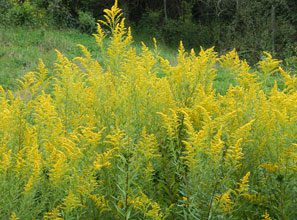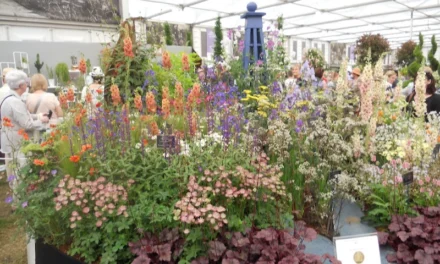I had one of those Aha Moments after four years in Beaufort and it came from a garden club member on a tour here from Chattanooga.
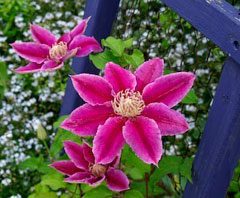 “Ya’ll have the most beautiful vines in Beaufort that I’ve ever seen anywhere in the world.” This was just days after my gardening cousin, visiting from Virginia, sighed audibly and said “Your vines are gorgeous, we can’t grow anything like this in Virginia,” indicating my neighbors gigantic 150 year old muscadine vine.
“Ya’ll have the most beautiful vines in Beaufort that I’ve ever seen anywhere in the world.” This was just days after my gardening cousin, visiting from Virginia, sighed audibly and said “Your vines are gorgeous, we can’t grow anything like this in Virginia,” indicating my neighbors gigantic 150 year old muscadine vine.
I suddenly felt guilty for four years of cutting and pulling vines out of my garden and off my porch. And that day I stopped. I now think vines are Beaufort’s ‘signature’ plant. Like azaleas are for the Charleston. Vines love it here! They grow like crazy in our neo-tropical climate. One of our first explorers, in one of the earliest descriptions of this area, commented that even before he saw land, he could smell a sweet scent blowing on the wind miles out in the ocean, and when he finally sighted land, he described “lush forested islands covered in blooming vines.” Possibly the trumpet vine? Or, at the very least muscadine, which is pictured in some of the earliest drawings of the Indian villages.
This Aha Moment also gave me the key to why my longtime Beaufortonian neighbors had so many more songbirds in their gardens than I did in mine. Birds love the cover and fruit from vines. As I’ve let vines in my garden literally go wild, the birds and butterflies have returned. What I once thought of as looking too ‘wild,’ I now think of as ‘lush.’ You should see the beautiful lighting effects created when the setting sun streams through green curtains of muscadine grape leaves, a romantic note that was missing from my garden before I let the vines go. Now I have them curling up the porch. Three or more at a time. Wisteria, muscadine and Autumn Clematis, along with Potato vine, all support each other in their scramble up some wire I put in for their support.
 In the back, (which I used to cut), there is now a massive Smilax, or Greenbriar, cascading down from the top of the pittisporum hedge. Smilax is an old Southern plant and many varieties of it grow here. My friend says her grandmother and her friends use to decorate their homes at Christmastime profusely with the vine, twining it over mantle pieces and through stair rails and chandeliers.
In the back, (which I used to cut), there is now a massive Smilax, or Greenbriar, cascading down from the top of the pittisporum hedge. Smilax is an old Southern plant and many varieties of it grow here. My friend says her grandmother and her friends use to decorate their homes at Christmastime profusely with the vine, twining it over mantle pieces and through stair rails and chandeliers.
Another vine I quit cutting, and am now a friend of, is the delicate five-leafed Virginia Creeper. It’s putting on a splendid show in a mid-sized Palmetto. Rhan’s Nursery in Port Royal carries a rare, variegated version of this plant that’s lovely, along with many other interesting vines and plants. Right now, they also have Ipomoea indica (Blue Dawn Flower) and the butterfly vine (Stigmaphyllom ciliatum) which has yellow flowers and seed pods that look like butterflies. They sell at the Port Royal Farmers Market on Saturdays and also allow garden groups and other interested parties to visit and buy from their wonderful wholesale nursery on Smilax Ave. in Port Royal. Their phone number is (843) 524-7353. Check out their website at plantfolks.com.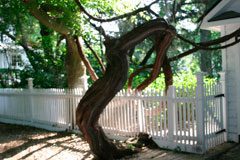
Some blooming vines you are, of course, familiar with, like Honeysuckle, Wisteria, & Carolina jasmine. If you are new here, there may be others you’ve seen but don’t know as well; like the native Trumpet Vine, with its tubular orange-red blooms that hummingbirds love, that scamper up pine trees up to 40 feet. (There’s a big one in Publix parking lot). There’s also a very pretty yellow variety called ‘Flava’ that’s often sold in nurseries. The Carolina Moonseed vine is another native that produces clusters of red berries that last until Christmas. Different vines have different attributes that can be used in the garden for different things: there’s the flowering vines, for blooms and scent, and then there are non-blooming vines like Creeping Fig, Ivy, Boston Ivy and Virginia Creeper, that can soften hardscape and add interest to a blank wall. Nothing can improve the looks of a blank wall or chain link fence faster than a vine. Vines add vertical interest to your garden and need relatively little space for their roots at the bottom, making them ideal for those small strips of earth you often find between a sidewalk and a blank wall. Some vines can grow up a wall by themselves, others need support. And ‘support’ may mean as little as some eyelet screws with a taunt wire strung between them, or something stronger (which is usually better), since vines can really increase in size and weight. Trellises, arbors, pergolas, or wrought iron supports, fences, brick walls, or other structures for supporting vines can be a great addition to your garden and give it an upright focal point.
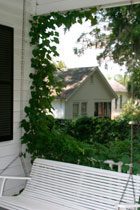 There are so many wonderful vines available to us today, with interesting variations in each vine group. Take wisteria for example: There’s a native American variety with relatively smallish blossoms, there’s a Chinese wisteria with larger flowers (and we see mostly around here girdling trees), and there’s a Japanese wisteria, with a longer blooming period than the Chinese one, that has been hybridized by the Japanese to have blooms up to 20 inches long! I saw a white one once that looked spectacular and had been trained into a standard small tree, as can be done with many vines. And the wisterias come in a range of colors that runs from pink, to blue, to purple, to white.
There are so many wonderful vines available to us today, with interesting variations in each vine group. Take wisteria for example: There’s a native American variety with relatively smallish blossoms, there’s a Chinese wisteria with larger flowers (and we see mostly around here girdling trees), and there’s a Japanese wisteria, with a longer blooming period than the Chinese one, that has been hybridized by the Japanese to have blooms up to 20 inches long! I saw a white one once that looked spectacular and had been trained into a standard small tree, as can be done with many vines. And the wisterias come in a range of colors that runs from pink, to blue, to purple, to white.
The same goes for the whole range of the beautiful flowering Clematis vines. They range from small white flowers (C. Monata) to dazzling large flowered varieties like ‘Nelly Moser’ and ‘Dr. Ruppel.’ And the Sweet Autumn Clematis has a delicate bloom in the fall. There are all kinds of surprising varieties of Honeysuckle, with beautiful blooms that have been developed. Same goes for the Passion Flower. It’s fun to hop online, google a category of vine, and just see what’s out there. They usually give you sources of seed and mail order plants, for those varieties of vine you can’t purchase nearby. 
You can also find out ways online of getting rid of the so-called ‘bad’ vines, like Kudzu and Oriental Bittersweet, that smother their host trees and give all other vines a bad reputation.
When selecting vines it’s also good to keep in mind the difference between deciduous vines – ones that lose their leaves – and evergreen ones, especially if you are using the vine to screen an unwanted view. Deciduous vines, even though they go away in the winter, usually take their leave only after a ‘grand finale,” like, for example, when a whole wall covered with Boston Ivy turns a beautiful red.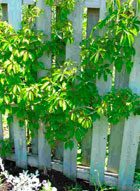
Here are some deciduous vines:
Cross vine
Trumpet creeper, Trumpet vine
American bittersweet
Clematis
Coral honeysuckle
Boston Ivy
Here are some evergreen ones:
Carolina jessamine
Confederate jasmine
Creeping fig
Ivies
Potato Vine
Climbing Roses and Climbing Hydrangea also do well here in the Lowcountry. And Lady Banksia rose, though not a vine but a rambler, can give very picturesque ‘vine like’ effects when trained up a tree or telephone post, or allowed to scamper across a brick wall and into neighboring trees, as does the Cherokee Rose.
I hope with greater awareness of vines, and how much they can add to your garden, that we can change the recent trend of seeing all vines as destructive to trees and homes, and subsequently ripping or cutting them down every time the garden maintenance crew arrives or the house is power washed. I was guilty of this ‘spic and span’ approach, too, but have since come to appreciate that what gives the greatest beauty to some of the older parts of town, like historic ‘Old Point,’ are the lovely old cascading vines that you see everywhere.
Once you start noticing and identifying vines, you’ll be surprised at where you’ll find them. The other day I was waiting on a friend at a dentist office and suddenly realized all the trees around the parking lot were covered with native vines (and birds). Instead of a long boring wait, I got to admire and try to identify some of the vines in this gorgeous, towering vertical ‘garden.’ Try it next time you’re stuck waiting for somebody!
Here are some online sources for some neat unusual vines:
www.plantdelights.com (Possom Grape Ivy, Climbing Asparagus, Pitcher’s Leather Flower)
www.diggingdog.com (large Clematis section, Climbing Hydrangeas)
www.heronswood.com (wonderful Clematis, unusual Honeysuckle and Kiwi vines)
www.parkseed.com (good in state source of Clematis, Honeysuckles, etc.)


